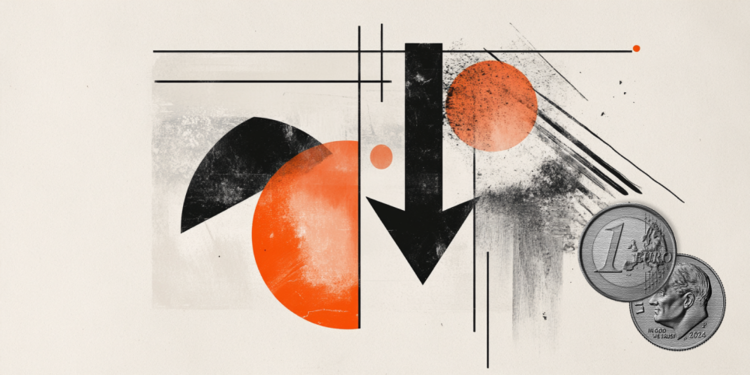- EUR/USD trades near a seven-week low, holding above the key 1.1400 support level.
- The Euro remains under pressure for the sixth consecutive day amid broad USD strength, with the US Dollar Index marking a fresh two-month high near the 100.00 psychological level.
- Germany’s CPI rises 0.3% month-over-month in July, while the annual rate holds steady at 2.0%, both in line with market expectations.
The Euro (EUR) trades under pressure for the sixth consecutive day against the US Dollar (USD) on Thursday, with EUR/USD struggling to recover as the Greenback holds firm near two-month highs. The pair tumbled to its lowest level since June 11 on Wednesday after the Federal Reserve (Fed) left interest rates unchanged, while stronger-than-expected US economic data reinforced the US Dollar’s bullish momentum. However, the pair found some support near the key 1.1400 psychological level, helping to limit further losses.
At the time of writing, EUR/USD is consolidating losses around 1.1411 during the American session, down nearly 2.83% so far this week. The pair is also on track to post its first monthly decline since December 2024.
Fresh US data released by the Bureau of Economic Analysis on Thursday provided more fuel for the US Dollar’s rally. The core Personal Consumption Expenditures (PCE) Price Index — the Fed’s preferred inflation gauge — rose 0.3% MoM in June, in line with expectations and up from 0.2% in May. On a yearly basis, core PCE rose by 2.8%, slightly higher than the 2.7% forecast. The headline PCE index also climbed 0.3% MoM and 2.6% YoY, both coming in above estimates, signaling sticky inflation pressures.
Personal spending rose 0.3% in June, just shy of the 0.4% forecast but a solid rebound from May’s 0.1% decline. Personal income increased by 0.3%, beating expectations of 0.2% and recovering sharply from the prior month’s 0.4% drop. Labor market data also showed resilience, with Initial Jobless Claims falling to 218K for the week, slightly below the 224K forecast — a sign the jobs market remains tight.
In response to the strong data, the US Dollar Index (DXY), which tracks the Greenback against a basket of six major currencies, surged to a fresh two-month high, trading near the key 100.00 level.
Earlier on Thursday, preliminary inflation figures from Germany offered a mixed picture and failed to lift the Euro. Data released by Destatis on Tuesday showed that the Consumer Price Index (CPI) rose 0.3% MoM in July, slightly above the 0.2% forecast and up from flat growth in June. On a yearly basis, CPI held steady at 2.0%, matching expectations. Meanwhile, the Harmonized Index of Consumer Prices (HICP) — the European Central Bank’s (ECB) preferred measure — increased by 0.4% MoM, in line with forecasts and notably stronger than the 0.1% print in June. However, the annual HICP eased slightly to 1.8% from 1.9%, coming in below the ECB’s 2% target and consensus expectations.
In a separate release, Eurostat reported that the Eurozone Unemployment Rate dipped to 6.2% in June, slightly better than the 6.3% expected. The previous month’s figure was also revised down to 6.2% from 6.3%, reflecting continued resilience in the region’s labor market.
Euro PRICE Today
The table below shows the percentage change of Euro (EUR) against listed major currencies today. Euro was the strongest against the Japanese Yen.
| USD | EUR | GBP | JPY | CAD | AUD | NZD | CHF | |
|---|---|---|---|---|---|---|---|---|
| USD | -0.02% | 0.38% | 0.75% | 0.15% | 0.03% | 0.03% | -0.05% | |
| EUR | 0.02% | 0.39% | 0.76% | 0.18% | 0.02% | 0.06% | -0.03% | |
| GBP | -0.38% | -0.39% | 0.38% | -0.21% | -0.37% | -0.33% | -0.41% | |
| JPY | -0.75% | -0.76% | -0.38% | -0.59% | -0.71% | -0.65% | -0.76% | |
| CAD | -0.15% | -0.18% | 0.21% | 0.59% | -0.06% | -0.12% | -0.20% | |
| AUD | -0.03% | -0.02% | 0.37% | 0.71% | 0.06% | 0.04% | -0.04% | |
| NZD | -0.03% | -0.06% | 0.33% | 0.65% | 0.12% | -0.04% | -0.08% | |
| CHF | 0.05% | 0.03% | 0.41% | 0.76% | 0.20% | 0.04% | 0.08% |
The heat map shows percentage changes of major currencies against each other. The base currency is picked from the left column, while the quote currency is picked from the top row. For example, if you pick the Euro from the left column and move along the horizontal line to the US Dollar, the percentage change displayed in the box will represent EUR (base)/USD (quote).

